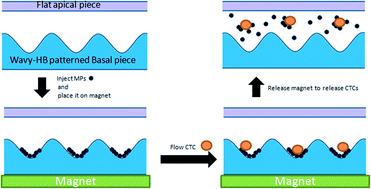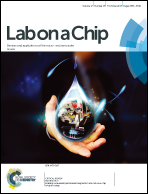Magnetic particles assisted capture and release of rare circulating tumor cells using wavy-herringbone structured microfluidic devices†
Abstract
A wavy-herringbone (wavy-HB) structured microfluidic device was used to effectively and selectively capture and release circulating tumor cells (CTCs) by using immunoaffinity and magnetic force. This device was designed to create passive turbulence and increase the possibility of tumor cells colliding with the device wall. Under an external magnetic field, magnetic particles (MPs) coated with anti-EpCAM against a tumor cell surface protein (EpCAM) were immobilized over the wavy-HB surface to capture tumor cells. After removing the magnetic field, the captured cells with surplus MPs were released from the device and collected; thus, these cells could be re-cultured for further analysis. Under optimized conditions, the capture efficiency of the tumor cells can be as high as 92% ± 2.8%. Capture experiments were also performed on whole blood samples, and the capture efficiency was in a high range of 81–95%, at different tumor cell concentrations. Such a method can potentially be used for CTC sorting from patient blood samples, CTC concentration monitoring, therapeutic guidance and drug dosage choice, and further study of tumors, such as drug screening and tumor mutations.



 Please wait while we load your content...
Please wait while we load your content...